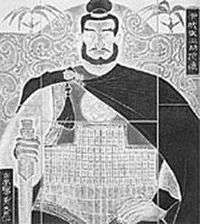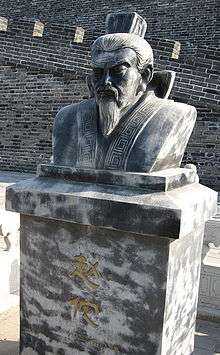Zhao Tuo
Zhao Tuo or Triệu Đà (Chinese: 趙佗; pinyin: Zhào Tuó; Vietnamese: Triệu Đà), was a Qin dynasty Chinese general who participated in the conquest of the Baiyue peoples of Guangdong, Guangxi and Northern Vietnam. After the fall of the Qin, he established the independent kingdom of Nanyue (Nam Viet) with its capital in Panyu (now Guangzhou) in 204 BCE.[1] Some traditional Vietnamese history scholars considered him an emperor of Vietnam and the founder of the Triệu dynasty, other historians opined that he was a foreign invader.[2]
| Zhao Tuo 趙佗 Triệu Đà | |||||
|---|---|---|---|---|---|
| King of Nanyue (Nam Việt) | |||||
 A statue of Emperor Zhao Tuo (Triệu Vũ Đế) in Xuân Quan communal temple, Văn Giang District, Hưng Yên Province, Vietnam | |||||
| King of Nanyue | |||||
| Reign | 203–137 BC | ||||
| Successor | Zhao Mo (Triệu Mạt) | ||||
| Born | ca. 240 BC | ||||
| Died | 137 BC (aged 103) | ||||
| Burial | |||||
| |||||
| House | Triệu dynasty | ||||
| Zhao Tuo | |||||||||||
|---|---|---|---|---|---|---|---|---|---|---|---|
| Chinese name | |||||||||||
| Traditional Chinese | 趙佗 | ||||||||||
| Simplified Chinese | 赵佗 | ||||||||||
| |||||||||||
| Vietnamese name | |||||||||||
| Vietnamese | Triệu Đà | ||||||||||
| Emperor Wu | |||||||||||
|---|---|---|---|---|---|---|---|---|---|---|---|
| Chinese name | |||||||||||
| Chinese | 武帝 | ||||||||||
| Literal meaning | The Martial Emperor | ||||||||||
| |||||||||||
| Vietnamese name | |||||||||||
| Vietnamese | Vũ Đế | ||||||||||
Life
Nanyue
Zhao Tuo was born around 240 BC in Zhending in the state of Zhao (within modern Hebei). When the state of Zhao was defeated and annexed by Qin in 222 BC, Zhao Tuo joined the Qin, serving as one of their generals in the conquest of the southern Baiyue. The territory of the Baiyue was divided into the three provinces of Guilin, Nanhai, and Xiang. Zhao served as magistrate in the province of Nanhai until his military commander, Ren Xiao, fell ill. Before he died, Ren advised Zhao not to get involved in the affairs of the declining Qin, and instead set up his own independent kingdom centered around the geographically remote and isolated city of Panyu (modern Guangzhou). Ren gave Zhao full authority to act as military commander of Nanhai and died shortly afterwards. Zhao immediately closed off the roads at Hengpu, Yangshan, and Huangqi. Using one excuse or another he eliminated the Qin officials and replaced them with his own appointees. By the time the Qin fell in 221 BC, Zhao had also conquered the provinces of Guilin and Xiang. He declared himself King Wu of Nanyue (Southern Yue).[3]
Conquest of Âu Lạc
According to Vietnamese historians, in 179 BC Zhao Tuo defeated An Dương Vương, king of Âu Lạc in what is now north Vietnam. This is not mentioned by Chinese historians.[4]
Conflict with the Han
In 196 BC, Emperor Gaozu of Han dispatched Lu Jia to recognize Zhao Tuo as king of Nanyue.[3] Lu gave Zhao a seal legitimizing him as king of Nanyue in return for his nominal submission to the Han.
In 185 BC, Empress Lü's officials outlawed trade of iron and horses with Nanyue. Zhao Tuo retaliated by proclaiming himself Emperor Wu of Nanyue and attacking the neighboring kingdom of Changsha, taking a few border towns. In 181 BC, Zhou Zao was dispatched by Empress Lü to attack Nanyue, but the heat and dampness caused many of his officers and men to fall ill, and he failed to make it across the mountains into enemy territory. Zhao began to menace the neighboring kingdoms of Minyue, Xiou (Western Ou), and Luoluo. After securing their submission he began passing out edicts in a similar manner to the Han emperor.[5]
In 180 BC, Emperor Wen of Han made efforts to appease Zhao. Learning that Zhao's parents were buried in Zhending, he set aside a town close by just to take care of their graves. Zhao's cousins were appointed to high offices at the Han court. He also withdrew the army stationed in Changsha on the Han-Nanyue border. In response, Zhao rescinded his claims to emperorship while communicating with the Han, however he continued using the title of emperor within his kingdom. Tribute bearing envoys from Nanyue were sent to the Han and thus the iron trade was resumed.[6]
Legacy
Zhao Tuo is considered by some Vietnamese historians to be one of the first King of Vietnam. Zhao Tuo is revered by many temples in Vietnam. His memorial is in Tuocheng Town, Longchuan County, Guangdong.
A street in Hiệp Phú Ward (District 9) in Ho Chi Minh City is named after him.[7]
Citations
- Ulrich
- Brantly Womack (2006). China and Vietnam: the politics of asymmetry. Cambridge University Press, 2006. p. 100. ISBN 0-521-85320-6.
- Watson 1993, p. 208.
- Taylor 2013, p. 14-16.
- Watson 1993, p. 209.
- Watson 1993, p. 210.
- Hồ Đình Quý (2007-11-20). "Vì sao chọn Triệu Đà để đặt tên đường? (Why choosing Triệu Đà to name the street)". Retrieved 2014-09-07.
References
- Taylor, Jay (1983), The Birth of the Vietnamese, University of California Press
- Taylor, K.W. (2013), A History of the Vietnamese, Cambridge University Press
- Watson, Burton (1993), Records of the Grand Historian by Sima Qian: Han Dynasty II (Revised Edition, Columbia University Press
- Ulrich, Theobald (2000). "Chinese History". ChinaKnowledge.de - An Encyclopaedia on Chinese History, Literature and Art. Theobald Ulrich. Retrieved 12 August 2019.
See Also
- History of China
- History of Vietnam
- Qin's campaign against the Yue tribes
- Nam Việt
- Triệu dynasty
- Phiên Ngung
- Trọng Thuỷ
- Han-Nam Việt War
- An Dương Vương
- Âu Lạc
- Phiên Ngung Palace
- Museum of the Mausoleum of King Triệu Mạt
- Luobowan Tomb No.1
- Đông Sơn culture
- Changsha (state)
- Minyue
- Yelang
- Bách Việt
Zhao Tuo Triệu Dynasty Born: 240 BC Died: 137 BC | ||
| Preceded by An Dương Vương as king of Âu Lạc |
King of Northern Vietnam 203 BC – 137 BC |
Succeeded by Zhao Mo as king of Nanyue |
